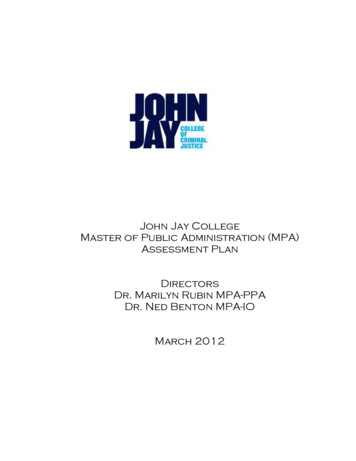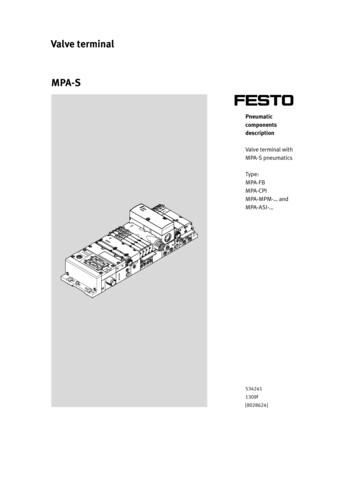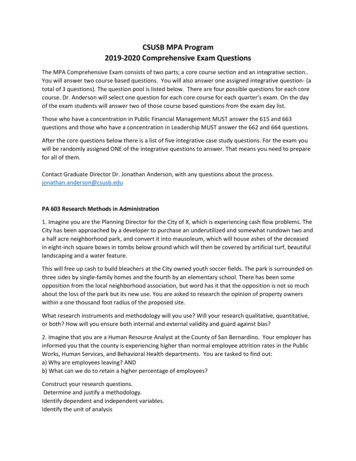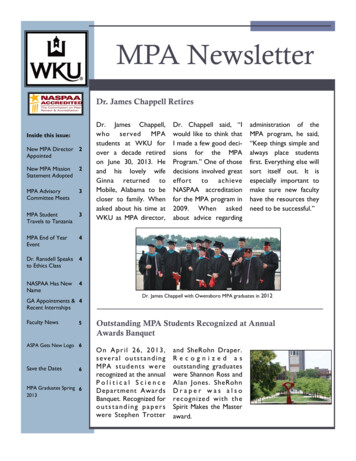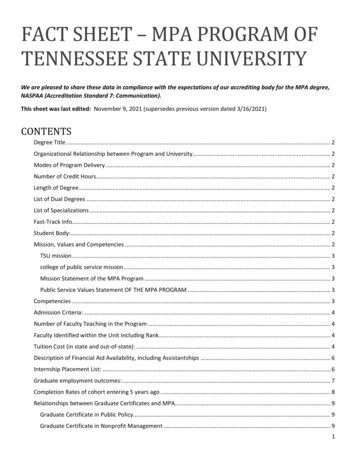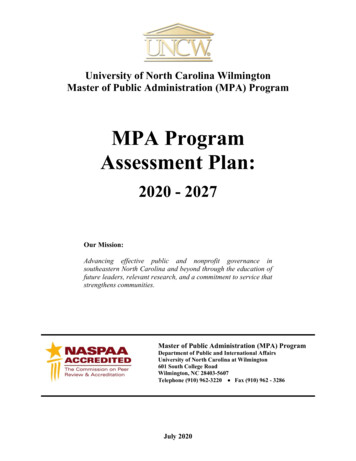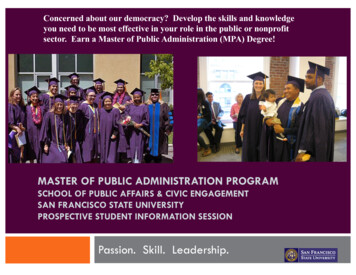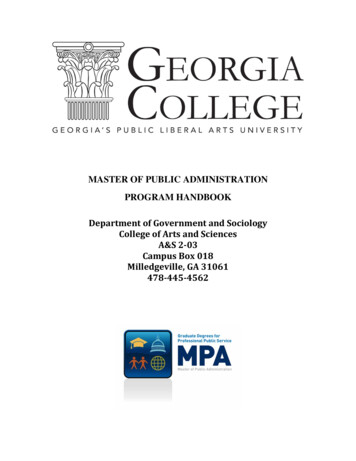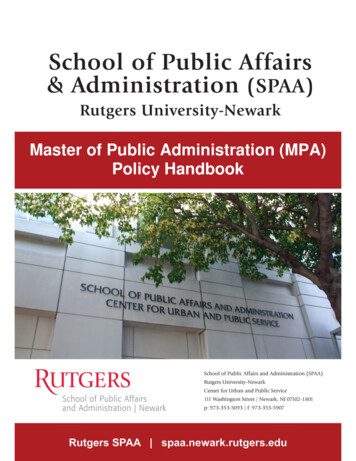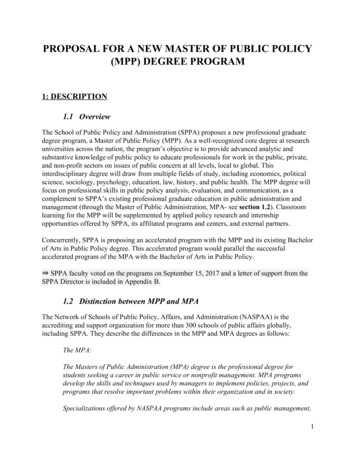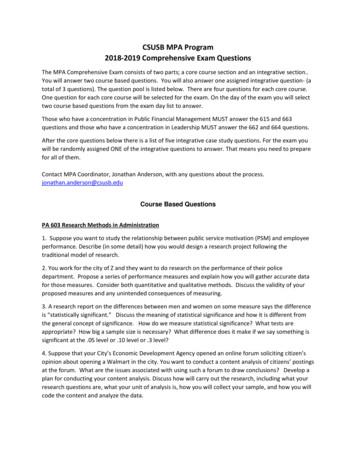
Transcription
CSUSB MPA Program2018-2019 Comprehensive Exam QuestionsThe MPA Comprehensive Exam consists of two parts; a core course section and an integrative section.You will answer two course based questions. You will also answer one assigned integrative question- (atotal of 3 questions). The question pool is listed below. There are four questions for each core course.One question for each core course will be selected for the exam. On the day of the exam you will selecttwo course based questions from the exam day list to answer.Those who have a concentration in Public Financial Management MUST answer the 615 and 663questions and those who have a concentration in Leadership MUST answer the 662 and 664 questions.After the core questions below there is a list of five integrative case study questions. For the exam youwill be randomly assigned ONE of the integrative questions to answer. That means you need to preparefor all of them.Contact MPA Coordinator, Jonathan Anderson, with any questions about the process.jonathan.anderson@csusb.eduCourse Based QuestionsPA 603 Research Methods in Administration1. Suppose you want to study the relationship between public service motivation (PSM) and employeeperformance. Describe (in some detail) how you would design a research project following thetraditional model of research.2. You work for the city of Z and they want to do research on the performance of their policedepartment. Propose a series of performance measures and explain how you will gather accurate datafor those measures. Consider both quantitative and qualitative methods. Discuss the validity of yourproposed measures and any unintended consequences of measuring.3. A research report on the differences between men and women on some measure says the differenceis “statistically significant.” Discuss the meaning of statistical significance and how it is different fromthe general concept of significance. How do we measure statistical significance? What tests areappropriate? How big a sample size is necessary? What difference does it make if we say something issignificant at the .05 level or .10 level or .3 level?4. Suppose that your City’s Economic Development Agency opened an online forum soliciting citizen’sopinion about opening a Walmart in the city. You want to conduct a content analysis of citizens’ postingsat the forum. What are the issues associated with using such a forum to draw conclusions? Develop aplan for conducting your content analysis. Discuss how will carry out the research, including what yourresearch questions are, what your unit of analysis is, how you will collect your sample, and how you willcode the content and analyze the data.
PA 611 Public Administration Theory and Practice1. Max Weber saw bureaucracy as a technically superior form of organizing. Robert Merton (and others),on the other hand, believed that bureaucratic structures are inherently dysfunctional. Discuss how it ispossible that bureaucracy is technically superior or dysfunctional or both? How do you reconcile thisapparent paradox?a) Why is bureaucracy claimed to be technically superior?b) Why do some say bureaucracy is dysfunctional,c) Is it possible for bureaucracy to be technically superior while also dysfunctional?Make sure to provide at least one real-world or hypothetical example to support your discussion.2. The past decade has seen a number of trends in governance. There is an increasing focus placed onadaptive/agile management, collaborative networks, and public private partnerships. What does theemphasis of these approaches suggest about the nature of governance? What does this suggest aboutthe capacity of current governance to address the issues that it faces? Do you think these trends arehere to stay or are they passing? Why or why not? In your discussion, please, be specific. Make sure toprovide real-world or hypothetical examples to support your arguments.3. What is public administration theory? (Make sure to reference at least one theory that originated inpublic administration literature). Is theory necessary for public administration? Discuss in detail thenature of public administration theories, their scope/uses, their contribution to practice and theirweaknesses. In your discussion you can focus on one specific theory or you could generalize to anapplicable group of theories.4. In recent years we have witnessed an increased number of efforts to make public bureaucracies moreaccountable and responsive. Please, provide detailed answers to the following questions (be specific inyour answers):a) What are some of the more important reasons behind this drive to make bureaucracies moreaccountable?b) To whom should public bureaucracies be accountable?c) What are some means through which bureaucracies can be held accountable?d) What are the desired results of having more accountable bureaucracies?PA 615 Public Financial Management1. While the economy has continued to improve since the Great Recession of 2007-08, the issue ofsustainability remains critically important for local governments. Discuss what the term fiscal stressrefers to as it applies to local government. Identify three (3) adverse conditions likely to occur to a city,or county, that is fiscally stressed and how they may be problematic. Discuss three (3) financialmanagement strategies that can help prevent local governments from becoming fiscally stressed.2. Local governments often face issues of resource scarcity. This is especially true when planning forcapital projects. From the perspective of a public manager, what information is necessary whendeveloping a capital improvement plan? What are the characteristics of a capital budget? Discuss the
various types of methods to finance capital projects along with their relative advantages anddisadvantages.3. Define and discuss the similarities and differences between monetary policy and fiscal policy. Providean actual example a monetary policy being implemented in the U.S. and an actual example of a fiscalpolicy being implemented in the U.S. Discuss the impacts on the economy after the policies wereimplemented.4. Discuss the value of financial reporting from the perspectives of a:1) public manager, 2) resident, 3) member of the business community.What are two (2) methods governments choose to report financial information to the public? What arethe advantages and disadvantages of each method?PA 650 Public Sector MIS1. From an IT strategic planning perspective, explain what is meant by IT outcomes and how they aredistinguished from IT outputs. Provide at least three examples. Explain the effect that an outcomefocused IT strategic plan has on the following:1)2)3)4)5)The responsibilities of the CIO,An enterprise architecture,The agency’s IT priorities,IT performance measurement,Agency success.2. The General Accountability Office (GAO) has found that enterprise-wide technology projects are ahigh-risk investment for all organizations – and that public-sector initiatives fail to meet expectationsapproximately twice as often as similar projects undertaken in the private sector. The BrookingsInstitution reports that major technology projects are failing in the public sector at an “alarming rate”and are resulting in “billions of dollars lost, embarrassment, redundancy, waste, and a loss in publictrust.”You are applying for the job as the CIO of a moderate-sized county government in which the CountyExecutive and County Board of Supervisors have made it clear that their top priority is the planning andsuccessful implementation of an enterprise-wide IT modernization effort. In preparing for yourinterview, you want to assure them that you are aware of the key differences between public andprivate sector IT projects, the primary causes of public sector IT disappointments, and the approachesand tools you would bring to the organization if you were to lead it.Write an essay that describes the briefing you would provide to county officials. Be sure to explain thefollowing: Your understanding of why private sector IT projects are more successful and what attributes ofprivate sector IT projects are often missing in public sector IT projects; The tools and approaches you would bring to the project that will greatly increase the likelihoodof success; and
The role that the non-technical executive in a public agency, with no direct oversightresponsibility over the agency’s technology program, can play to minimize the likelihood of an ITfailure?3. “Big data” and “knowledge management” are relatively new concepts that are significantly changingthe focus of many public-sector agencies. This change is certain to shift the focus of public agenciesfrom internal data management to data access and utilization on a much different level --- and willplace many new requirements on internal IT organizations to support a variety of new opportunitiesand initiatives.Given that agency IT programs are certain to begin giving priority attention to “big data” as they plan forthe growth of their future technology capabilities, please demonstrate your understanding of “big data”and “knowledge management” by answering the following:a) Define and provide examples of what is commonly meant by “big data” and “knowledgemanagement”.b) Identify two contemporary government functions which you believe would be greatlyenhanced with an effective program of knowledge management. Describe the specific datarelated issues and problems that currently constrain performance.c) How might an effective system of big data and knowledge management contribute to thetransformation of an agency?d) The concept of “big data” is overwhelming to many. How would you use the principles ofknowledge management to ensure the practical and efficient use of “big data”?4. You have been hired by a California State University to develop and teach a new course - PA 6505.“Emerging Public IT Management Issues.” You want to ensure that your students find the courseinteresting and provocative, so you have decided to redesign the entire course to reflect controversial ITmanagement issues. You have selected the following FIVE issues that will be the initial focus of the newcourse:1.2.3.4.5.Enabling CSU students to take courses from any CSU campus,Engaging students and faculty in the development of IT systems and capabilities,How e-learning will change the traditional classroom experience,Measuring the performance of future IT programs,Ethical considerations associated with e-government and enhanced IT capabilities.Your Department Chair wants you to lead a discussion of this course among the department faculty andhas asked you to write and distribute a short memo that briefly describes each of these issues andexplains their relevance and importance to the university and the students who will be exploring them.Please draft that memo.PA 662 Human Resource Management in the Public Sector1. Discuss why human resource management knowledge and skills are indispensable for all publicsector managers at all levels. Provide examples of the utility of HR skills at the supervisory,managerial, and executive levels (either positive or demonstrating the liability of havingdeficiencies).
2. Rank-in-person systems have a very different philosophy and operation than rank-in-job systems.Compare and contrast rank-in-person versus rank-in-job systems with examples. For example, what arethe technical differences, when do they tend to be used in organizations, what challenges are therewhen both are used in the same organization, etc.?3. You have been asked to provide an introductory talk about benefits for new employees. You are onlyproviding the overview; HR specialists will discuss the topics you introduce in more detail. It should havea positive tone. Assume and use the benefits typical of large California agencies for your talk. While youwill not address compensation, you should touch on all types of benefits from medical, to retirement, toat least a handful of employee-friendly benefits.4. Briefly discuss the strengths and weaknesses of using formal appraisal systems. Then outline featuresof a good appraisal system and explain why you chose those features. Finally, describe thecircumstances in which one might lean towards a trait-based, behavior-based, or results-based approachto appraisal.PA 663 Public Budgeting and Finance1. Define performance budgeting. From a public manager’s perspective, discuss the rationale behindthe push to use performance data in the budgeting process (e.g., Government Performance and ResultsAct or the Program Assessment Rating Tool (PART)) along with the benefits and challenges. What are thebenefits and challenges a local government would face if they implemented performance budgeting?2. Discuss the various approaches state and local governments may utilize to generate revenue inCalifornia. What are the economic and social factors that influence revenue generation ideas? Discusstwo budgetary theories related to revenue generation.3. Public budgeting is challenging because governments are typically faced with the issue of scareresources. Discuss the issues around resource allocation issues that elected officials and publicmanagers face in the context of the question V. O. Key posed nearly 80 years ago: “On what basis shall itbe decided to allocate x dollars to activity A instead of activity B?”How can elected officials and public managers address this inherent challenge today?4. Since 1978, Proposition 13 has had a profound effect on the economy of California. Discuss the impactProposition 13 has had on local governments and the residents of California. As a result of thelegislation, many cities were forced to develop new policies in reaction to these changes. Identify 3 fiscalpolicies/strategies commonly used by local governments in response to “Prop 13.”PA 664 Management of Public OrganizationsFor all answers, emphasis should be placed on whether the student has developed and articulated acogent, well-thought-out argument.
1. How is public service leadership different from other forms of leadership? How is this form ofleadership contingent (or not) upon the distinct motivations of public service employees andvolunteers? What is the role of intrinsic versus extrinsic motivation in managing employees?2. How has public sector management changed over the past few decades and what impact have thosechanges had on how leaders “manage?” Provide examples for each change you describe.3. Why is communication competency important for public managers? Why is it especially important forthe external relations challenges public service leaders face? Identify some common strategies ofinterpersonal communication and apply them to at least three specific examples of external relationschallenges. Clearly articulate the possible ramifications of different approaches. For each strategy, notehow culture, gender, or personality differences might influence its effectiveness.4. Identify at least four market mechanisms that have been used by some governments to manage theiroperations. What are the advantages and disadvantages of using market mechanisms, both empiricallyand normatively?PA 672 Administrative Law1. Identify and discuss eight elements of the Constitution important to administrative law. An exampleis the Commerce Clause.2. Specify when various types of rulemaking procedures are used as well as the major elements of therule making process related to each type. Specifically, what type of rulemaking is used when there is: (a)merely a technical clarification, (b) a significant rule change in a policy spurred by a concrete change inlaw, (c) a change in standards allowed under a broad environmental, safety, or health related law allowing for significant agency interpretation and in which there are large corporate interests involved inthe process, (d) a needed administrative policy change, but direct personal input from citizens might behelpful via public hearings, and (e) only a small number of players may be involved in the policy issueand there is a possibility of reaching a consensual approach?3. Distinguish and compare absolute and qualified immunity and to whom it applies. Provide a variety ofhypothetical instances in which public servants are covered by these two types of immunity, andsituations in which it does not apply or is lost by public servants.4. Freedom of information requests have become an important element of the effort to ensure thatlarge public agencies are accountable and transparent to the public, media, etc. Discuss the history ofFOIA, the exceptions, the volume of FOIA requests and the demands this can make on agency resources(provide at least one concrete example of the volume), the general procedures by which FOIA requestsare made, and a two concrete examples of FOIA requests from your personal experience or the news.PA680 Public Policy Analysis1. Define, explain, and contrast the politics of interest and the politics of conscience and how theyinfluence policy making in the United States, including their relationship to the application of ethics. Besure to include examples in your response and discuss the difficulty in identification and application ofthese influences within and between political parties.
2. Identify the actors in the policymaking process at the federal, state, and municipal levels ofgovernment. Is the influence of actors equal in each level? If not equal, where has such influencebecome unbalanced in your view? Provide specific examples and rationale.3. The traditional theory of policymaking is that legislators make policy and public managers carry it out.However, most scholars argue that this simple politics/administration dichotomy does not accuratelyreflect the policy-making process in most contemporary public administration environments.a) How do public managers engage in policymaking?b) How do legislators engage in policy implementation?c) Is the politics/administration dichotomy is still valid today? Why or why not.d) Provide one detailed example in an area with which you are familiar.4. How does an issue become part of the public policy “agenda?” Out of all the issues that exist, why dosome come to legislative attention and many do not? Consider the classic “Garbage Can Model” ofCohen, March and Olsen (1972). Do you agree or disagree? Why?
Integrative QuestionsQuestion 1 Leadership/ManagementOne of the most important aspects of leadership is integrity and its complement, ethics. This isespecially important in the public sector because leadership impacts everyone and is integral to thelegitimacy of the democratic process. It is partly for this reason that our Public Administration programhas the slogan of “Committed to Ethical Public Service" and supports the ASPA Code of Ethics.Identify four principles of ethical leadership in the public sector that you feel are important. Define yourterms and locate these principles within leadership theory. Explain how these principles of ethicalleadership contribute to effective leadership in the public sector.We know that leadership happens at all levels of employment. For each of the four ethical leadershipprinciples you have identified, provide examples of how they can be practiced (and how YOU willpractice them) in both entry-level work and formal leadership positions.Question 2 Policy ProcessThe policy process is similar at all levels of government in the United States, but there are differences inissues, in stakeholders and in political and legal dynamics. Some elected officials in City X are concernedabout their air quality. They want to create a policy that addresses that problem. Taxes, regulations andcongestion pricing are a few of the proposed policies. You are asked to draft a policy brief addressingthe issue for presentation to City Council.a) How is public policy developed? How do you propose to manage the policy developmentprocess?b) The problem articulated is about air quality. What other issues may be impacted by addressingthe problem of air quality? How would you address them?c) Identify internal and external stakeholders and how they may impact any proposed policy.d) Recommend a policy alternative and back up your solution with reasons and evidence.Question 3 Critical Thinking and Problem SolvingYou work for the Finance Director of the City of Somewhere. The City Council is concerned about thepossibility of an economic downturn that may put pressure on the City Budget. The City Manager hasasked the Finance Director (and the Finance Director has asked you as Assistant Finance Director) tocome up with strategies for net cost reductions of the budget by 5%, 10% and 25%. For the purpose ofusing a common data set for the City of Somewhere, you can view the City of Modesto Proposed FY2018-19 Budget at Item/2765. You can view theCity of Modesto Proposed FY 2018-19 Capital Improvements Budget e/Item/2757How will you proceed in response to the request from the City Manager.
a) Identify challenges, opportunities, and stakeholder interests in this cutback management planning.b) Identify alternative approaches to the problem.c) Identify the obstacles that must be overcome if your analysis and recommendation are to besuccessful and how you would overcome them.d) Recommend a policy action supported by evidence and reasoning.Question 4 Public Service PerspectiveYou are a special assistant to the City Manager who has asked you to research the issue of “contractcities:” that is, cities that contract with private firms, nonprofit organizations, or other governmentagencies for most basic governmental services.a) What are the costs and benefits of becoming a “contract city?”b) What are the impacts for residents, for taxpayers, for current employees, for the public interest, forthe budget?c) Are there other beneficial alternatives to regular employees providing nearly all city services?d) Make a recommendation with a supporting rationale.Question #5 Diversity/CommunicationsEmployees of your organization are preponderantly white, although the regional population consists ofa majority of Hispanic, Black and Asian citizens. Demographics of your region have changed over recentyears. Your organization has been around for many years and a large number of your employees havebeen with the organization for decades.There have been numerous letters to the editor criticizing your organization for itsdemographics. Recently a protest rally held in front of your office accusing the organization of racismattracted media attention. Not only local, but also national news outlets have requested interviews.You are the chief diversity officer of the organization and are tasked with assembling a team to create apolicy statement that can be used for responses to media and citizens. Draft a policy statement forconsideration by top management accompanied by a one-page memo explaining the rationale for thepolicy.Your policy statement and explanatory memo should:a) Briefly report how you created your team;b) Note what tools, evidence and documents you will utilize to create the policy statement;c) Show your understanding of the political climate, the U.S. Constitutional and legal framework, and thetheory of representational bureaucracy.d) Identify an immediate and a long-term change the city will commit to in order to reduce the tension.
CSUSB MPA Program 2018-2019 Comprehensive Exam Questions The MPA Comprehensive Exam consists of two parts; a core course section and an integrative section. You will answer two course based questions. You will also answer one assigned integrative question- (a total of 3 questions). The question pool is listed below.
